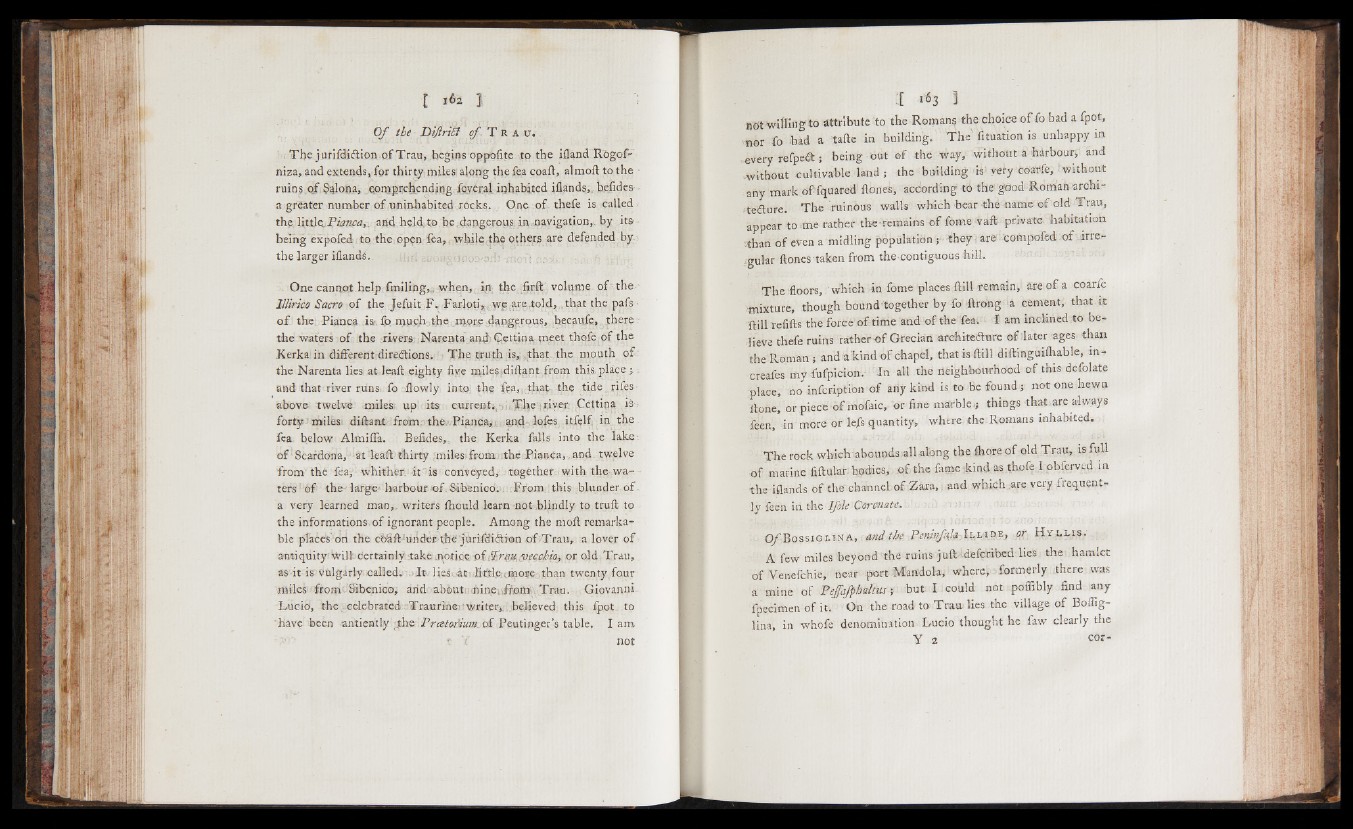
O f thè D ijlriêl o f . T R a u.
The jurifdiilion of Trau, begins oppòfìte to the ifland Rôgof-
niza, and extends, for thirty miles along the fea coaft, al mod to the ■
ruins.of Salona, comprehending, fevêrah inhabited iflands,, befides-•
a greater number o f uninhabited rôcks. One o f thefe is called
thç. \iit\e Fianca, and held.to.becdt3.rigerpu,s, in-navigation, by its
being expofed to the open fea, while the others are defended by
the larger iflands. jl,t- ..„.o.-.u'or-cvi' . |0 ■ . ,
One cannot help fmiling,,, when, in the full volume o f the
Illirico Sacro o f the Jefuit F. Farlpti,. wp are.told, that the pafs
o f the Fianca is fo njuch the more ¡4ang£rou,s, hecaufe, there
the waters o f the rivers -Natenta' and; Çettâna,. meet thofe of the
Kerka in differentdiredtions. The truth is, that the mouth o f'
the Narenta liesatleafl eighty five mjlesid.iitant from this- place }-,
and that river runs, fo flowly into the f?a>Kth,ay the tide riies
above twelve miles- up its eurrentipiiThe ¡fiver. Celtica .is--
forty mi las i diftant from the. Fianca, - and lofes itfçlf in the
fea below Almifli. Befides,, the Kerka falls into the lake-
o f Scardona, -at leaft thirty miles-from the Fianca, and. twelve
from thé fea, whither it is conveyed, together with the-waters'
é f the large harbour o f Sibenico. . Prom this blunder of
a very learned man,, writers fhould learn nofeblindlyto trufl to
the informations o f ignorant people. Among the moil remarkable
places òri the céSftJunder-thë j'ùrifd‘i(5tkin .of-Trau, a lover o f
antiquity w ill dertainly ¡take .noticejof vErq&yçççhta, or old,Trau,
as it is vulgariyoalled; • lb UeSc-atr Jitï-lftcùaoiieothan twenty.four
miles from- Sibenico, arid aboutcmneafitem.. Trau. Giovanni
Lucid, the -celebrated' Traufiriei'writer,..believed this fpot to
hâve been untiently !fhe\ Trinivi«»: o f Peutipger’s table. I am
not
not willing to attribute to the Romans the choice o f fo bad a fpot,
nor fo bad a tafle in building. T he fituacion is unhappy in
-every refpeét ; being Out ©f the way, without a hàrbour, and
-without cultivable land; the building p yefy ooarfe;1 without
any mark o f fquared ilones, according to the' good Roman archi-
tedlure. The ruinous walls which bear the - n a m e o f old Trau,
appear tom e rathef- the-remains o f fome fa ft private habitation
-than o f even a midling population they ; are compofed o f irregular
ilones taken from the contiguous hill.
The ■floors, which in fome places flill remain, are o f a coarfe
■mixture, though boundtogether by fo flrong a cement, that it
flill refills the force o f time and o f the fea-. i am inclined to believe
thefe ruins rather o f Grecian architeflttre of dater ages than
the Roman ; and a kind o f chapel, that is flill diflinguifhable, in-
creafes my fufpicion. In all the neighbourhood o f this defolate
place, no infcription o f any kind is to be found-; not one hewn
ilone, or piece o f mofaic, or fine marble.; things that, areal ways
feen, in more or lefs quantity, where the Romans inhabited.
The rock w h i c h abounds .all along the fhore of old Trau, is full
o f marine fiflular bodies, o f the fame ¡kind as thofe I obfervtd m
the iflands o f the channeLof Zara, and wdxich.are very frequent-
]y feen in tlie Ifâîe CoYMiate* p \
O / 'B o s s ig lin a , and tbt. P.erfnfiilalJlhi~iv.e, pf I lv nm s .
A few miles beyond the ruins jufl-'-defcribcd lies the hamlet
of Venefchie, near port Mandola, where, formerly .there , was
a mine of Pejlifphultus-, but I could not poffibly find any
fpecimen of it. On the road to T ran lies.the village o f Boffig-
lina, in whofe denomination Lueio thought he faw clearly the
Y 2 cor*